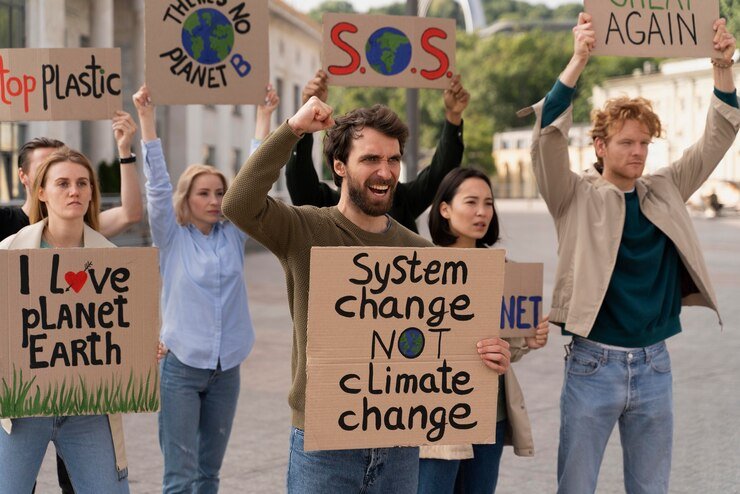Climate Change: What to Expect in the Next 10 Years?
Introduction
Climate change is one of the greatest challenges of the 21st century, directly affecting the environment, the economy, and global society. Understanding its causes, effects, and the current situation is essential for planning a sustainable future and addressing this reality.
What is Climate Change?
Climate change refers to alterations in global climatic patterns, caused both by natural factors and human activities (anthropogenic causes). Naturally, the Earth’s climate has always changed due to events such as volcanic eruptions, solar cycles, and variations in the planet’s orbit. However, in recent decades, human activities, such as the burning of fossil fuels, deforestation, and intensive agriculture, have significantly accelerated this process.
These activities release greenhouse gases, such as carbon dioxide (CO₂) and methane (CH₄), which trap heat in the atmosphere and contribute to global warming. The increase in average global temperatures has triggered a series of consequences for the climate and ecosystems.
Awareness of climate change began to gain strength in the 20th century, with the advancement of scientific research. Reports, such as those produced by the Intergovernmental Panel on Climate Change (IPCC), highlighted the urgency of the problem and the potential consequences of not taking action.
The Current State of the Global Climate
Currently, the evidence of climate change is undeniable. Data collected by organizations such as the NOAA show a continuous increase in global temperature since the Industrial Revolution, with the last eight years being the hottest on record. Other concerning signs include:
- Sea level rise due to the melting of glaciers and polar ice caps.
- Extreme weather events, such as heat waves, floods, and prolonged droughts, becoming more frequent and intense.
- Changes in precipitation patterns, affecting ecosystems and communities.
These phenomena indicate that climate change is not just a future problem, but a current crisis.
Impacts Already Felt by Humanity
Climate change already directly affects millions of people worldwide. In the agricultural sector, extreme events have reduced food production, generating food insecurity. The rise in sea levels threatens coastal cities and small islands, forcing population displacements, known as climate migrations.
Furthermore, the loss of biodiversity is alarming, with many animals and plants struggling to adapt to rapidly changing climatic conditions. Human health is also at risk, with the increase in heat-related diseases and the spread of vectors such as mosquitoes into new regions.
Why Acting Now Is Essential?
Science is clear: climate change is already happening, and its impacts will intensify if we do not act quickly. Protecting the planet requires global efforts, such as reducing carbon emissions, transitioning to renewable energy, and adopting sustainable practices in daily life. Every decision matters to ensure a better future for the next generations.
How to Address Climate Change: Ongoing and Necessary Responses
Climate change is a reality that demands coordinated and urgent actions. Governments, businesses, and civil society play an essential role in seeking solutions to minimize environmental impacts and promote a sustainable future. Here are the key initiatives currently in progress and the strategies needed to combat this global crisis.
Global Policies to Combat Climate Change
Among the main international responses is the Paris Agreement, signed in 2015, which brings together almost all countries in the world with the commitment to limit global temperature rise to 1.5°C above pre-industrial levels. This agreement sets targets for reducing greenhouse gas emissions and encourages the transition to a low-carbon economy.
The Conferences of the Parties (COP), held annually, are crucial for monitoring the progress of this agreement. In recent events, countries have discussed more ambitious measures, such as ending the use of fossil fuels and increasing financial support for developing nations facing the effects of climate change.
Even so, the implementation of these policies faces challenges, such as economic interests and resistance from certain sectors. Despite this, significant progress has been made, and the role of global policies remains indispensable.
Sustainable Technologies and Innovations
Technological development is a powerful tool in the fight against climate change. Among the most promising solutions are:
- Renewable energy, such as solar and wind power, which are already replacing fossil fuels in many regions.
- Carbon capture and storage, which removes excess CO₂ from the atmosphere.
- Regenerative agriculture, a practice that not only reduces emissions but also improves soil health and enhances its carbon absorption capacity.
New technologies, such as long-lasting batteries and sustainable transportation systems, are also in development, promising to revolutionize sectors such as urban mobility and logistics.
The Role of Civil Society and the Private Sector
Civil society has played a leading role in the fight against climate change, spearheading global movements like Fridays for Future, which mobilizes young people worldwide. Additionally, NGOs and community projects promote local actions, such as reforestation and environmental education.
The private sector also plays a crucial role. Leading companies have adopted corporate sustainability policies, investing in low-impact operations and promoting circular economy practices. A notable example is the transition to carbon-neutral supply chains.
Moreover, conscious consumption is a powerful tool. Individuals can reduce their carbon footprint by choosing sustainable products, minimizing waste, and supporting companies that adopt responsible practices.
Why Acting Together Is Essential?
The fight against climate change is a collective effort. Global policies, technological innovations, individual, and corporate actions are the pieces of the puzzle needed to protect the planet. Through combined efforts, it is possible not only to mitigate the effects of this crisis but also to build a greener and more sustainable future.
How to Mitigate the Impacts of Climate Change: Practical Actions and Resilience
Climate change is a reality that threatens the future of the planet, but there are concrete actions that can be taken by individuals, communities, and governments to minimize its impacts. Below, we explore strategies to reduce emissions, raise awareness, and build a sustainable future.
Individual and Community Actions
Every person can play a significant role in combating climate change. One of the most effective ways is to reduce the carbon footprint by:
- Supporting circular economies, prioritizing recycled and reusable products, which reduce waste and environmental impact.
- Adopting sustainable transportation, such as bicycles, public transport, or electric vehicles, which help reduce greenhouse gas emissions.
Additionally, participating in local actions is a powerful way to promote change. This can include tree planting in urban areas, river and beach cleanup campaigns, and supporting community projects aimed at sustainability. Climate activism, led by organizations and movements, also has a growing impact, pressuring governments and companies to adopt greener policies.
The Importance of Education and Awareness
Education is an essential tool in the fight against climate change. Informing people about the impacts of human activities on the environment helps build a more conscious society willing to take action.
- Schools and universities play a vital role by including sustainability content in their curricula, preparing future generations to face climate challenges.
- The media has the power to spread information about climate change to the general public. Educational campaigns can show how everyday practices, such as rational energy use and reducing plastic consumption, make a difference.
- Scientific knowledge is another key factor. Detailed climate studies can guide public policies and support informed decision-making. For example, data on rising sea levels can encourage preventive measures in vulnerable coastal areas.
Hope for the Future: Building Resilience
Despite the severity of the climate crisis, there is still hope. Successful initiatives worldwide demonstrate that it is possible to reverse or mitigate environmental damage. For example:
- Mass reforestation in countries like India and China has restored ecosystems and absorbed carbon from the atmosphere.
- Energy transition in various nations, such as Denmark, which has heavily invested in wind energy, proves that a sustainable economy is viable and profitable.
Building resilience is fundamental to addressing the challenges already in progress. Cities worldwide are developing flood-resistant infrastructure and investing in technologies that help mitigate the impacts of extreme weather events.
Although the challenges are immense, there is still time to act and prevent the most devastating scenarios. The key is to unite global, regional, and individual efforts, with a clear focus on sustainability and innovation.
Conclusion
Mitigating the impacts of climate change requires collaboration from everyone. From simple everyday actions to structural changes promoted by governments and companies, every step counts. Education and awareness are powerful tools, while successful initiatives show that change is possible. Together, we can build a greener, safer, and more sustainable future.







